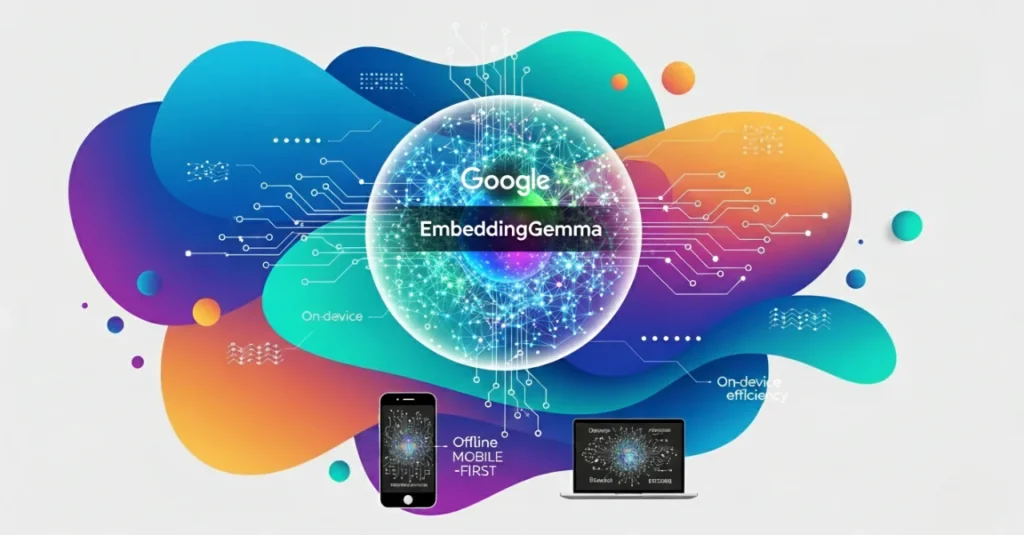Google DeepMind has just unveiled EmbeddingGemma, a compact yet powerful embedding model that runs directly on your device.
Unlike cloud-only AI, this model delivers state-of-the-art multilingual performance while preserving privacy, efficiency, and speed — even without an internet connection.
Key Takeaways
- EmbeddingGemma is Google’s new 308M-parameter open embedding model.
- Runs offline on phones, laptops, and edge devices with <200MB RAM.
- Tops MTEB benchmark for multilingual models under 500M parameters.
- Enables faster, private Retrieval Augmented Generation (RAG) pipelines.
- Integrates with Hugging Face, LangChain, Ollama, and more developer tools.
EmbeddingGemma is Google DeepMind’s latest open-source embedding model designed for on-device AI. At 308M parameters, it runs efficiently on under 200MB RAM, delivers top multilingual performance on the MTEB benchmark, and powers offline semantic search, RAG pipelines, and private AI applications without relying on cloud servers.
Google’s New Bet on On-Device AI
Google DeepMind has officially launched EmbeddingGemma, a lightweight but high-performing text embedding model built to run directly on consumer hardware. At just 308 million parameters, it promises best-in-class performance for its size, allowing developers to deploy Retrieval Augmented Generation (RAG), semantic search, and classification systems without relying on cloud servers.
The release comes as demand for privacy-first and offline AI grows worldwide. From smartphones to laptops, users increasingly expect generative AI features to function even without connectivity.
Why EmbeddingGemma Stands Out
EmbeddingGemma builds on Google’s Gemma 3 architecture, with support for over 100 languages. It ranks as the highest-performing open multilingual embedding model under 500M parameters on the Massive Text Embedding Benchmark (MTEB).
Key design highlights include:
- Matryoshka Representation Learning (MRL): Lets developers shrink embeddings from 768 to 128 dimensions for speed and storage savings.
- Quantization-Aware Training (QAT): Cuts RAM use below 200MB while preserving accuracy.
- Real-time inference: Achieves <15ms embedding inference for 256 tokens on EdgeTPU hardware.
These optimizations make the model viable for everyday devices — from Android phones to desktop applications.
Unlocking Mobile-First RAG Pipelines
Embeddings are the “connective tissue” of generative AI pipelines. By converting text into high-dimensional vectors, they allow systems to understand meaning, context, and nuance.
In a RAG pipeline, embeddings determine which documents are retrieved for context. Poor embeddings yield irrelevant results; high-quality embeddings produce reliable answers.
EmbeddingGemma strengthens this retrieval step, enabling mobile-first pipelines where queries can be matched against stored documents locally. Together with Gemma 3n, the model powers context-aware responses without needing to send sensitive user data to external servers.
Everyday Use Cases
Google highlights multiple ways developers and consumers might use EmbeddingGemma:
- Offline search: Scan personal files, emails, or notifications without internet.
- Custom chatbots: Build domain-specific assistants that work on-device.
- Contextual tools: Classify and route queries to mobile apps in real time.
A demo showcased how EmbeddingGemma could embed open browser pages in real time, enabling instant retrieval of relevant articles when a user asks a query — all without leaving the device.
Industry Response & Developer Integration
EmbeddingGemma is already compatible with popular AI frameworks, including Hugging Face, LangChain, Ollama, llama.cpp, MLX, transformers.js, Weaviate, and LMStudio. Developers can download the weights on Hugging Face, Kaggle, and Vertex AI.
This broad integration strategy signals Google’s intent to make the model accessible beyond its own ecosystem. Analysts see it as part of a larger push toward open, modular AI tools that can rival closed alternatives.
Why It Matters Globally
With AI adoption rising in emerging markets where stable internet is not always guaranteed, on-device AI is becoming critical infrastructure. EmbeddingGemma’s ability to run efficiently offline could accelerate adoption in regions where cloud-first models are impractical.
It also reinforces the privacy-by-design trend, ensuring sensitive data like personal messages or medical queries stay local.
Google vs. the Field
EmbeddingGemma enters a competitive space. Meta has pushed lightweight versions of LLaMA for mobile, while startups like Mistral and Cohere are exploring efficient embedding alternatives. But Google’s benchmark-topping results and deep integration with its Gemma ecosystem could give it a head start.
Conclusion
EmbeddingGemma combines speed, efficiency, and multilingual reach in a package small enough for consumer hardware. For developers, it unlocks mobile-first RAG and privacy-preserving AI features. For users, it promises smarter, faster, and more personal AI — no internet required.
